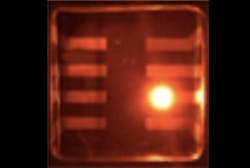Scientists at Los Alamos National Laboratory (Los Alamos, NM) have incorporated colloidal quantum dots into a new type of electrically pumped light emitting diode (LED) containing an integrated optical resonator, which allows the device, when optically pumped, to function as a laser.1 The device is a step toward mass-producible electrically pumped quantum dot lasers. These novel, dual-function devices clear the path towards versatile, easy-to-fabricate laser diodes; because the output wavelength can be tailored by changing the size of the quantum dots, the technology can potentially result in lasers with wavelengths anywhere within a broad spectrum.
Colloidal quantum dot lasers can be manufactured using cheaper, simpler methods than modern semiconductor laser diodes that require sophisticated, vacuum-based, layer-by-layer deposition techniques. Solution-processable lasers can be produced in less-challenging lab and factory conditions, and could lead to devices that would benefit a number of emerging fields, including integrated photonic circuits, optical circuitry, lab-on-a-chip platforms, and wearable devices.
For the past two decades, the Los Alamos quantum dot team has been working on fundamental and applied aspects of lasing devices based on semiconductor colloidal quantum dots. The Los Alamos researchers have now successfully resolved several challenges on the path to commercially viable colloidal quantum dot technology. In particular, they demonstrated an operational electrically pumped LED that also functioned as an optically-pumped, low-threshold laser.
To achieve these behaviors, they incorporated an optical resonator directly into the LED architecture without obstructing charge-carrier flows into the quantum dot emitting layer. Further, by carefully designing the structure of their multilayered device, they could achieve good confinement of the emitted light within the ultrathin quantum dot medium on the order of 50 nm across. This is key to obtaining the lasing effect and, at the same time, allowing for efficient excitation of the quantum dots by the electrical current. The final ingredient of this successful demonstration was unique, home-made quantum dots perfected for lasing applications per recipes developed by the Los Alamos team over the years of research into the chemistry and physics of these nanostructures.
Presently, the Los Alamos scientists are tackling the remaining challenge, which is boosting the current density to levels sufficient for obtaining population inversion.
REFERENCE:
1. Jeongkyun Roh et al., Nature Communications (2020); https://doi.org/10.1038/s41467-019-14014-3.

John Wallace | Senior Technical Editor (1998-2022)
John Wallace was with Laser Focus World for nearly 25 years, retiring in late June 2022. He obtained a bachelor's degree in mechanical engineering and physics at Rutgers University and a master's in optical engineering at the University of Rochester. Before becoming an editor, John worked as an engineer at RCA, Exxon, Eastman Kodak, and GCA Corporation.
